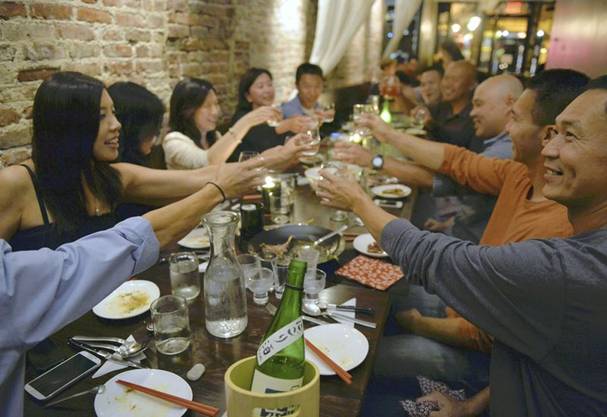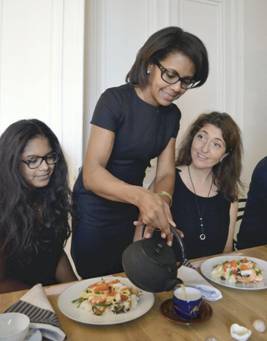Thirst for sake, green tea growing abroad
Posted on November 22, 2013 On The Japan News by The Yomiuri Shimbun
http://the-japan-news.com/news/article/0000771009

The Yomiuri Shimbun
Customers make a toast with sake at the Sakamai izakaya in New York.
The Yomiuri Shimbun
The popularity of washoku traditional Japanese cuisine—from everyday dishes to luxurious kaiseki ryori—has spread to big cities such as New York and Paris, influencing the daily diets of residents there. With washoku expected to be added to the UNESCO Intangible Cultural Heritage list in December, The Yomiuri Shimbun is examining the cuisine through the eyes, and palates, of non-Japanese people. The following are the third installments in a four-part series on washoku.
NEW YORK—“Cheers!” As this echoed around the Sakamai izakaya pub in the heart of New York, customers raised a glass of sake for a toast and then took a sip. They chomped on a selection of assorted sashimi slices ($12) and homemade tofu ($6).
A number of casual restaurants serving Japanese food and sake at reasonable prices have opened in New York over the past few years.
At Sakamai, which was opened at the end of last year by Hawaiian Natalie Graham, customers gather around a big table to eat, drink and chat.
Graham, 31, visited sake breweries across Japan and learned to not only appreciate the flavor of each sake but also its history before selecting about 80 kinds—including Nanbu Bijin and Uragasumi—for her restaurant’s shelves. Sake at her restaurant starts from $8 per glass.
“The allure of sake is that it has a refreshing flavor that wine doesn’t have. I want my customers to enjoy the aroma, too,” Graham said.
She pours sake into a wine glass instead of a standard sake cup to allow customers to more easily smell and appreciate its aroma.

The Yomiuri Shimbun
Audrey Pulvar pours Japanese tea from a traditional pot in Paris.
Chizuko Niikawa, who manages a public relations company that promotes sake in the United States, said: “Along with such luxurious washoku cuisine as kai-seki ryori and sushi, sake is already well known among gourmet food enthusiasts. But over the past couple of years, izakaya and other casual washoku restraurants have opened [in the United States], boosting the number of sake fans here.”
According to foreign trade statistics, about 14,000 kiloliters of sake was exported in 2012, double the amount exported a decade ago and marking a record high.
Nara Prefecture-based Yucho Shuzo Co.’s junmaishu (pure rice sake) Kaze no Mori became popular due to its elegant flavor and smoothness. The brand is currently sold in 11 countries.
“The domestic market has been shrinking. It’s become crucial to find markets outside Japan,” said Yoshihiko Yamamoto, Yucho Shuzo’s executive director.
Along with the popularity of sake, the export volume of green tea has also increased. The volume in 2012 was 2,351 tons, valued at about ¥5 billion.
Kyoto Obubu Tea Farms, in Wazuka, Kyoto Prefecture, which cultivates and sells Japanese tea, sells its products to 44 countries via the Internet. Its overseas sales this year have doubled that of last year.
“Exported Japanese tea costs two or three times more than black tea or coffee. But once people experience the flavor and aroma of Japanese tea, they take a keen interest in it,” said Yasuharu Matsumoto, the vice president of Kyoto Obubu Tea Farms. The company also holds seminars around the world to explain the pleasures of green tea.
In addition to tea leaves, bottled tea is sold at delis and cafes along with washoku dishes.
Part of daily life
PARIS—French TV reporter Audrey Pulvar became interested in Japanese food culture after being exposed to Japanese literature. Almost every day now, she drinks hojicha (roasted tea), sencha (steeped tea) or matcha (fine green tea).
“The washoku I had in Japan was made with quality ingredients, and perfectly done,” she said. “Whenever I eat sushi and drink tea in Paris, I can’t help but praise the sophistication of Japanese food culture.”
Along with the washoku boom, the export of common Japanese ingredients has grown. Soy sauce maker Kikkoman’s affiliate company, which sells Japanese food wholesale, receives orders for high-grade frozen fish, tofu, shirataki noodle konnyaku and even dorayaki pancakes with red bean filling. For people overseas, washoku seems to no longer be just another kind of ethnic food.
Original Article: The Japan Times by Yomiuri Shimbun
http://the-japan-news.com/news/article/0000771009
